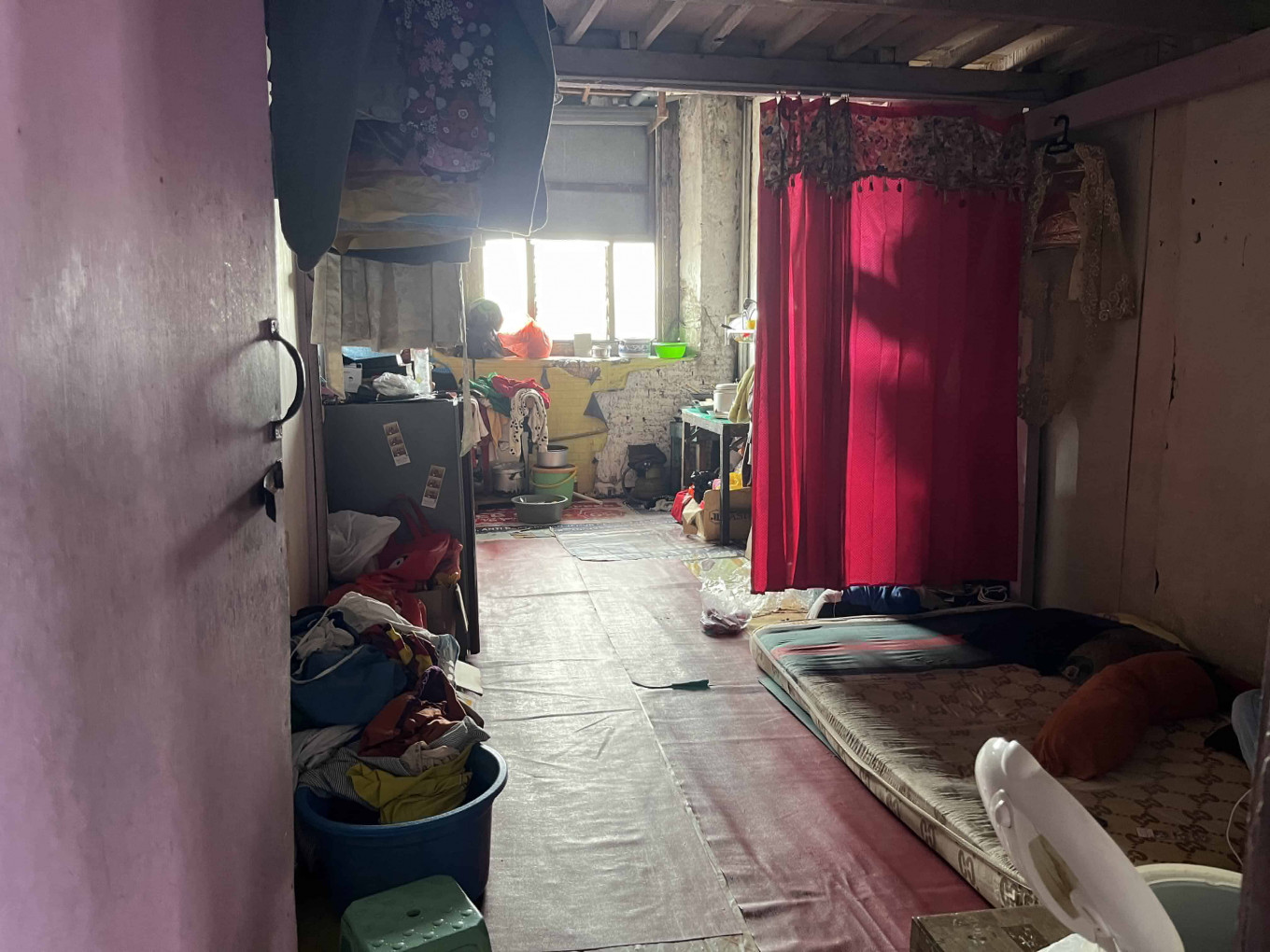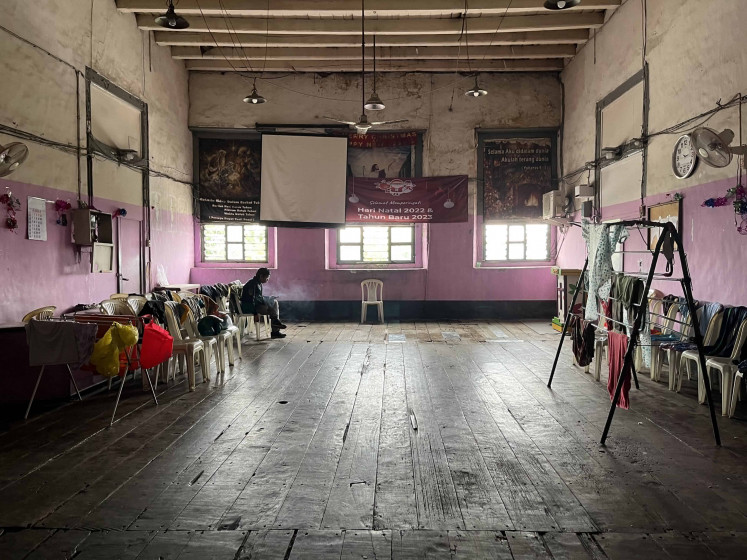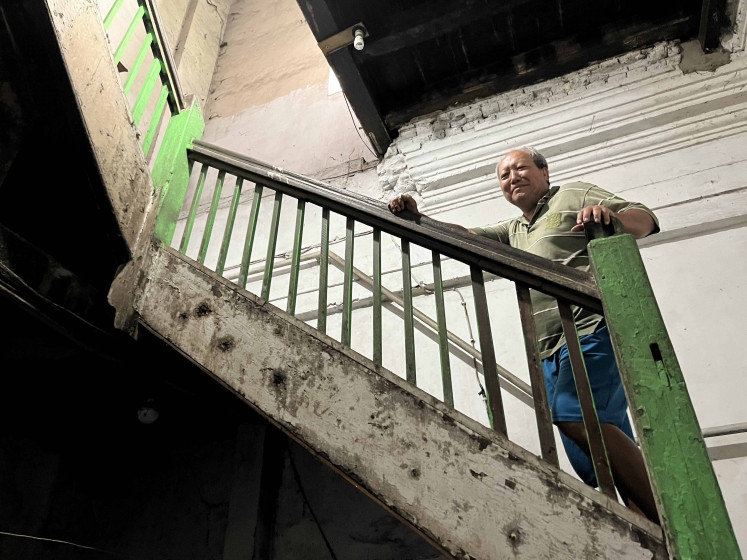Popular Reads
Top Results
Can't find what you're looking for?
View all search resultsPopular Reads
Top Results
Can't find what you're looking for?
View all search resultsGedung Setan: 'Devil's house' keeps nonmainstream history
Change text size
Gift Premium Articles
to Anyone
T
hough people in the area think of it as a haunted house, the building plays a vital role in preserving a part of Indonesian history and culture through its residents' heritage and memories.
The nation’s second-largest city of Surabaya, the provincial capital of East Java, boasts skyscrapers that can hold their own next to those in capital city Jakarta. Standing out like a beacon in the middle of the enormous high-rises that line Jl. Banyu Urip Wetan is a structure with a distinctly Dutch style.
Completed in 1809 and nicknamed Gedung Setan, meaning the devil’s house, the structure’s history is as convoluted as its name suggests.
During the colonial era, it housed the offices of J.A. van Middelkoop, governor of the Dutch East India Company (VOC).
It was then purchased by Chinese Indonesian doctor Teng Khoen Gwan, also known as Teng Sioe Hie, who converted it into a mausoleum for his and other Chinese Indonesian families.
Gedung Setan’s location is significant because of its proximity to other Chinese tombs in the Banyu Urip and Girilaya areas, and over 63 families as well as a church in Surabaya have called the building home for two centuries.
In the wake of the 1965-1966 massacre that targeted members of the banned Indonesian Communist Party (PKI) and by extension, members of the Chinese ethnic minority, the building provided a haven for local Tionghoa (Chinese Indonesian) families.
And in 2013, the Surabaya municipal administration declared Gedung Setan a cultural heritage site.
For the past decade, Djie Djwan Tek, also known as Sutikno Djiyanto, has been the manager of Gedung Setan, where he also lives while he works as an informal wholesale trader. Members of his family have filled the post of Gedung Setan’s “building coordinator” for three generations.
“If you look around at life in this area, how could I think selfishly about myself,” Sutikno said.
The 66-year-old father of three was born and raised at Gedung Setan, along with his eight siblings. His father, Djie Tjian Hian, became the first building coordinator in 1948, when he received a mandate from doctor Khoen Gwan to take care of the building.
‘Lost’ past
Why has such a magnificent structure become known by such a terrifying moniker?
According to the article “Bisnis di Balik Upacara Kematian Etnis Tionghoa di Surabaya, 1967-1998” (The business behind the funeral rites of Tionghoa in Surabaya, 1967-1998) by Olivia Daisiprima Santoso and Shinta Devi ISR and published in 2019 in Lensa Budaya: Jurnal Ilmiah Ilmu-Ilmu Budaya (Cultural lens: Scientific journal of cultural studies), many residents fear that the building is haunted because it is located close to local cemeteries.
Sutikno said the area was not electrified in the 1960s, and the local people reported seeing ghostly apparitions in the structure at night.
“It was all dark, and many people were scared to walk past the building,” he added.
Multifunction: The facilities at Surabaya’s Gedung Setan, which was built in 1809, also includes a church that serves as a multipurpose room. (JP/Yohana Belinda) (JP/Yohana Belinda)Sutikno explained that not long after Indonesia celebrated its independence, Khoen Gwan was prompted to make significant adjustments to his initial idea following the 1948 Madiun affair.
Briefly, the incident unfolded on Sept. 18, 1948, when Musso Manowar, the leader of the People's Democratic Front (FDR) grouping left-wing parties and militant PKI factions, took over the East Java city of Madiun and declared war on the Indonesian government, allegedly leading to extrajudicial killings of both government troops and civilians.
Read also: Survivors of 1948 Madiun affair speak out
People of Chinese ancestry fleeing the violence during that time sought safety at Gedung Setan with the help of the Chung Hwa Hui (CHH), or Tionghua Association, a conservative, pro-Dutch political organization that had pushed for the inclusion of ethnic Chinese and their right to vote in the Dutch colonial government.
A second influx of Chinese Indonesians took refuge in Gedung Setan in 1965, when they were singled out because of rumors that all members of the minority group had ties to the PKI. Many thus relocated to the building until conditions allowed them to return to their original communities.
Unfortunately, when asked about Khoen Gwan’s archival records, Sutikno revealed that many documents had been lost due to the negligence of his predecessor, Ong Djoe Moy.
“That is something that I regret the most,” he admitted. Sutikno added that some of Khoen Gwan’s descendants had allegedly emigrated to the United States, and rumors circulated that the Teng family tomb had been relocated to Malang, around 100 kilometers south of Surabaya.
Yerry Wirawan, a historian based in Jakarta, suggested that the lack of documentation on notable Chinese Indonesians was due to the fact that the published literature tended to focus on national heroes, such as leading figures of the independence movement and the national revolution and their heroic deeds.
“It’s the honest truth that Chinese Indonesians are seen as outsiders by many Indonesians,” he said, and that this had caused many to eventually forget about the history of the country’s Chinese ethnic minority.
Yerry pointed out, however, that recent years had seen an uptick in the number of Chinese Indonesian figures who were recognized in Indonesia’s national hero canon, such as the well-known Manadonese Naval officer John Lie, who also went by Jahja Daniel Dharma, who had served in Singapore, Penang, New Delhi and other areas in the Asia-Pacific.
Harmonization of diversity
Gedung Setan may look deserted and eerie, but its inhabitants are anything but ghostly.
The majority of the residents are of Chinese ancestry, with some having lived in the building for well over half a century.
One of the oldest residents is Oey Lioe Nio, 83, who has called Gedung Setan home since 1948, when she and her parents fled their hometown of Caruban in Madiun regency.
Now bedridden due to a stroke, she recounted a time when hundreds of refugees sheltered in the 213-year-old colonial structure. “I remember sleeping on top of an amben [wooden bed] along with other refugees,” she said.
More than 50 years later, Lioe Nio still lives at Gedung Setan, but her daughter has relocated to Sidoarjo, around 30 km south of Surabaya. The others residents help care for her, including changing her diapers.
Self-reliant community: Sutikno, the third-generation manager of Gedung Setan, says the building’s residents rely on each other or donations to renovate broken parts of the 213-year-old Dutch structure. (JP/Yohana Belinda) (JP/Yohana Belinda)At least 300 people had sheltered in the building in the days following the Madiun affair, according to Sutikno, citing information he had learned from his father. Some later moved back to their hometowns once the situation had settled down.
Today, however, not all of Gedung Setan’s residents are of Chinese ancestry. Many share commonalities with the Javanese and Madurese cultures, which have been incorporated into their everyday lives without conflict.
Sutikno recalled that many of the residents had been Confucian at one time, but most had converted to Christianity or Islam. Sutikno said the diversity of the building’s occupants meant that the community celebrated many holidays, including Christmas, Lunar New Year and Idul Fitri.
But because the majority of residents was Chinese Indonesian, Sutikno said Lunar New Year was by far the most joyous occasion. He recalled that his mother would prepare a communal feast for the residents every so often.
“Ever since my mother passed away in 2009, we haven’t had any feasts anymore. I miss the custom,” he said, but he and other married residents still gave children angpao, red envelopes filled with holiday money.
Gedung Setan is also filled with the joy of its younger residents who were born and raised there.
Liem Henny, now 33, is among the community’s younger generation and runs a tiny snack shop on the ground level near the building’s entrance.
“What I like about being here is that it’s really lively,” Henny said, referring to the communal residence.
But she still hopes for a better life in the future, perhaps settling in a developed neighborhood in Surabaya.
“Of course, it’s everybody’s dream to own a comfortable house to live in, but for now, I’m enjoying my time here,” she said.
Trying to endure
Although life at Gedung Setan might be vibrant, full of joy and color, parts of the structure are crumbling and pose a danger to its inhabitants.
Sutikno said a great deal of maintenance work needed to be done for the roof, but the costs were particularly high because the building was private property. He said the residents sometimes chipped in to fix some parts of the building, or otherwise waited for help from good Samaritans.
“We received some donations from the alumni of Satya Wacana [Christian] University, in Salatiga,” he added.
Sutikno and other residents still planned to repair the roof over the building’s “wet side”, which frequently leaked during the rainy season, though he usually tried to provide a temporary fix by covering the leak with a tarp. This at least kept the mattresses and floors from getting wet.
Gedung Setan was a haven for Chinese Indonesian refugees fleeing the so-called Communist purge in the latter half of the 1960s, and it continues to serve a similarly vital function by housing the Chinese Indonesian descendants of the original 1948 residents, as well as others.
“Everyone can live in the building as long as we have space left, but for now, we are at full occupancy,” Sutikno said.
Living in the colonial building is almost rent-free, costing just Rp 15,000 (US$1) per resident. The rent is then broken down as follows: Rp 8,000 goes toward paying the property tax, Rp 2,000 to an informal fund for helping residents who have lost family members, and Rp 5,000 as the resident’s contribution to the electricity bill and any repairs.
“After a death in a family, we try to donate Rp 300,000 to the [surviving] family members,” Sutikno said.
“My life should be useful to others,” he added.













